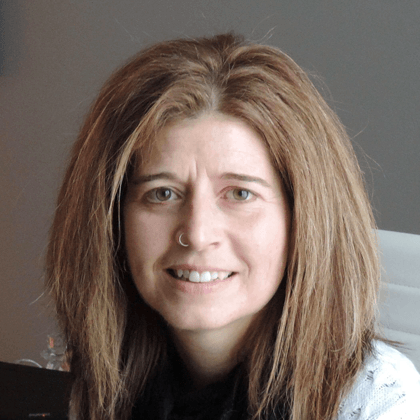Patti Ranahan
Associate Professor, Applied Human Sciences
Blended Learning Couse Design, Applied Human Sciences

AHSC 322, Fundamentals of Child and Youth Care Work
Approx. 50 Students (20 graduate and 30 undergraduate)
Why did you choose to blend your course?
This was a cross-listed course that had two separate syllabi and two separate assessment strategies. Consequently, Patti determined that creating a blended learning course would help to facilitate the differentiated between the two groups of students. Online lectures meant that graduate students with more in-depth knowledge could scan through online lectures more quickly while undergraduates may have needed more time to process. In class, she was able to group graduate students together and have them work on projects and assign them different tasks or additional layers to learning activities more easily from the undergraduates.
What was the structure?
Before beginning her blended design journey, Patti attended several workshops and accessed resources on blended course design offered by the CTL to help guide the planning process. The course began with three initial face-to-face classes to set up the course and for students to get to know the group members they would be working online with. These initial meetings were important in setting the foundation of the course and in building relationships with students. The additional face-to-face sessions were strategically placed throughout the term to be at the beginning of each module. Overall, there were about 6-7 in-person meetings and the remaining weeks were online.
What kinds of teaching/learning activities take place in the classroom?
The in-person classes mostly served as introductions to each of the modules, but they also included guest speakers and a visit from the subject librarian to provide guidance on their assignment. They also had the opportunity to do their first group task, which was applying the theory to a case study, in-class and get immediate feedback before they began working together online.
What kinds of teaching/learning activities take place in the asynchronous part of the course?
Lecture and podcasts were available for students to work on individually, but a big part of the online work were the mini presentations that students did in their groups. Students worked together on video presentations that asked them to apply the principles from the course and relate it to outside sources. Videos were uploaded to Moodle and shared with other students, who also provided feedback; this peer feedback was an important part of the course to help students engage with each other and their work.
What are the main changes you made to your teaching?
Because courses that have a significant online portion require more time and energy, Patti did spend more time on the development and maintenance of this course. This work involved organizing resources, inputting dates, adding links, instructions and grading criteria and rubrics, colour coding online versus in-person classes, and more. The move to online required her to be more explicit about assignment criteria and grading. This in turn gave her the opportunity to adapt her teaching in all courses. For example, her approaches to assessing students have become flexible so that students can demonstrate learning in a variety of modalities and formats while still meeting the course learning outcomes. She also devoted more time to providing feedback, and the feedback on the tasks, including the weekly mini presentation videos had to be timely so that they could use the feedback as they created the following week’s video.
What do you do to connect with and provide support to your students in the asynchronous part of the course?
Every Monday, the instructor sent check-in emails, which included reminders about in-person classes. Patti said that students often emailed her, and she kept in regular contact with many students via email. She also met with each individual pod during the term and provided abundant and timely feedback for each of the video presentations. She also provided video how-tos for assignments that outline each step in completing assignments and other videos for finding resources.
Patti also surveys students to gauge students’ comfort level with the design of the course and adapts to address any concerns.
How do your students benefit from blended learning?
Patti felt that that the greatest benefit to the course was the flexibility, and the graduate students benefited the most from this format. The group work aspect of the course also meant that students coming into the program were able to get to know members of their cohort. It may also be worth noting that through a survey, students said that the amount of interaction they had with other students in this course was the same or greater than those in other courses.